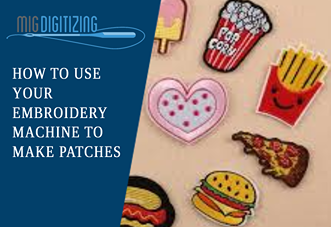
Embroidered patches are simple and straightforward to make with your embroidery machine, and they can be extremely profitable. To boost your embroidery business revenues, you may quickly embroider distinctive and high-quality patches with basic low-cost supplies.
Needed Embroidery Supplies:
Use sturdy twill patch fabric with a crinoline backing created specifically for embroidered patches, such as the ones sold. Poor outcomes and a waste of labour and materials will follow from using lighter, flimsier cloth.
Sharp Needles: To penetrate the tightly woven twill cloth, a sharp needle is required. Make sure you get the right needle for your machine: home machines need flat shank needles, whereas commercial machines need round shank needles.
Heat Seal Film Fuse-N-Bond: This film will give your patches a professional finish and allow your customers to iron them on themselves.
Process
Stick a piece of StickyStitch Peel & Stick Stabilizer through the hoop. Score the wax paper and peel it off once it's hooped to reveal the adhesive stabiliser underneath.
Choose from a variety of Pre-Made Blank Patches
Take your patch and place it over the stitched outline. This will ensure that the patch is centred and straight.
Make your design on the patch by embroidering it. A size 11 or 12 sharp point needle is recommended.
Remove the patch from the stabiliser after you're through, and you'll have a finished sew-in patch. Continue to step 6 to heat seal the back and make an iron-on patch.
Cut a piece of Fuse-N-Bond Heat Seal Film that is slightly smaller than your patch out of it.
Use an iron with a temperature of 260 degrees and press and hold for about 4 seconds with the wax paper facing up. Allow the fuse-n-bond and patch to cool before proceeding.
Pull the wax paper corner off slowly once it has cooled. If the fuse-n-bond sticks to the wax paper, either you didn't use enough heat and pressure, or you didn't let it cool down enough.
You now have a professional-looking patch that can be ironed onto any garment.
Steps To Transfer Embroidery Patterns to Fabric
Transferring embroidered patterns to fabric doesn't have to be complicated, and there are several options available. The texture and thickness (and colour) of your fabric, as well as the resources you have on hand, will typically decide which transfer method you employ. Tracing, transfer, and utilising an embroidery stabiliser are the three major ways for transferring your embroidered pattern to your cloth.
Transfer Method
Transferring your design is an option to tracing your pattern directly onto your cloth. Iron on pens and pencils from Sulky is a terrific method to use the printed embroidery pattern right away. To use this approach, trace the back of the pattern with iron on pen/pencil, then flip it onto your fabric (pen/pencil marks down) and iron until it is transferred. To avoid smudging the lines, keep your iron still when ironing, and you can pull up your paper to see how much of the lines have transferred. You can also trace your embroidered pattern on tracing paper, then retrace the lines with the iron on pen/pencil on the back.
Make sure you're drawing on the back of the pattern; otherwise, when you flip it over to iron it on the fabric, your design will be inverted. To be safe, mark which side of the pattern is right side up so you don't mistakenly transfer the wrong side. This procedure can result in less delicate linework being transferred to your fabric (especially if your fabric isn't extremely smooth), and these ways can leave a lasting mark on your fabric. Check the manufacturer's directions for your specific pen/pencil, and try on a scrap piece of fabric first.
Stabilizer Method
If you're working with a textured cloth or don't want to trace your design, utilising a photocopier is a great alternative. Sulky Sticky Fabri-Solvy, for example, makes transferring your design a breeze. You can buy it in a variety of sizes and even rolls, but if you want to print it, use letter-sized sheets. Water soluble vs. sticky, and soluble vs. peel away are just a few of the options.
You may also draw directly on the stabiliser (or trace your pattern onto it), but the best part about it is that it can be printed. First, test your printer to ensure that you're printing on the correct side of the stabiliser. Cut out your pattern, peel off the backing paper, and adhere it to your cloth once it's been printed. Before glueing on the stabiliser, make sure the fabric is stretched in your hoop or frame; otherwise, the design may buckle after you put it in the hoop.
You stitch right through the stabiliser, and when you're through, simply wash the stabiliser away with your stitching. Rinse it until there is no trace of it on the cloth or under the stitching.
Tracing Method
The tracing process works best on smooth, light-colored fabric. The first step is to get your embroidery pattern printed off (or trace it onto paper or tracing paper). If your fabric is thin enough, you might be able to trace your paper pattern directly onto your fabric. However, in order to see through your cloth, you'll usually need a light source behind your embroidered pattern. You can use a lightbox or tape your pattern to a bright window, then tape your fabric over top. Lightboxes come in a variety of sizes and prices (the Crayola Light-Up Tracing Pad is a good example of a low-cost choice), or you can use a tablet.



